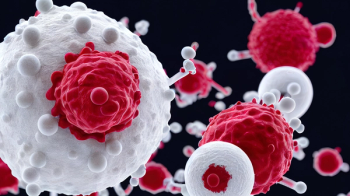
- June 2022
- Volume 16
- Issue 3
ONS Annual Congress Focuses on Increasing Nurse Comfort and Patient Understanding in Cancer Care
This year’s congress showcased strategies for communicating sensitive topics, patient experiences with immunotherapy treatments, updates in the utility of medical cannabis, and more.
Creating a Safe Space Is The First Step in Initiating Sexual Health Conversations With Patients With Cancer
Although not every patient with cancer will experience a sexual health crisis during treatment, each will experience some form of sexual health change, according to Sage Bolte, PhD, LCSW, CST.1 Therefore, it is important that oncology nurses establish that a patient can turn to them if and when they want to discuss issues related to their sexual health.
“Every single one of them will have sexual changes,” said Bolte, chief philanthropy officer and president of the Inova Health Foundation. “They will have questions, whether it’s during treatment, after treatment, or 3 years after treatment. [Nurses] will be the ones that they reach out to so that they don’t feel scared and isolated and confused when those issues come up.”
She added that with some patient populations, it is still not “necessarily generationally appropriate [to have these conversations], and it may be uncomfortable for them. So, it is [often] our providers [who need] to be the ones to bring forward the conversation.”
In a presentation during the 47th Annual Oncology Nursing Society Congress, Bolte, along with Elaine Wittenberg, PhD, FACH, an associate professor at California State University, Los Angeles, and Joy Goldsmith, PhD, a professor of communication studies, at the University of Memphis in Tennessee,
To better engage with patients, oncology nurses may need to ask themselves: “What is my comfort level discussing sexual health?” and “What are my particular strengths in helping patients and their partners reclaim their own bodies?” Nurses may also need to reflect further on how comfortable they are with their own body and sexuality, their own positive image, and whether they are at a place of peace to overcome personal barriers and initiate these conversations. “It is OK if you’re uncomfortable with those words,” Bolte noted. “We’re taught to be a little uncomfortable with those words. [But] we have to look at what triggers that discomfort so we can show up for our patients without showing that discomfort.”
Furthermore, nurses can help promote more meaningful dialogue by keeping the conversation positive and centered on the patient. For example, Bolte said it is a better approach to tell a patient, “Cancer and its treatments have such significant impacts on all aspects of our lives, including our sexual health. This is normal. I would love to provide you with some information,” rather than telling them, “You can discuss sexual failure with me” or “I am trained not to laugh.” Overall, Bolte recommended looking for “very simple, nonthreatening ways to open a conversation with the information that [the patient] is providing.”
Reference
Bolte S, Goldsmith JV, Wittenberg E. Tools of the trade: communicating sensitive topics. Presented at: 47th Annual Oncology Nursing Society Congress; April 27-May 1, 2022; Anaheim, CA.
Patients With Cancer Share Mixed Experiences With Immunotherapy
Patients with cancer are divided on their expectations with checkpoint inhibitors,
Results revealed that 27% of patients believe that their immunotherapy treatment will “help [them] live longer,” whereas 19% believe the therapy will “cure the cancer,” and 15% believe it will “improve [their] life quality.”
More than a quarter of patients expressed conviction that this treatment strategy would be “effective” against their disease, and another 25% felt it would be “very effective.” Fifteen percent were unsure whether it would be effective, 14% thought it would be somewhat effective, and 11% had no expectations. Other patients responded that they believed the treatment would allow them “to have less [adverse] effects [AEs] than chemotherapy,” “to stop the tumor from growing,” and “to delay the need for stronger chemotherapy.”
In terms of symptoms, tiredness was found to be the most common AE. For those who experience an AE, calling the oncologist was the most common response (21%). However, 15% of patients responded by calling their oncology nurse, 10% discussed the AE with family, and 9% chose to manage the AE alone. Eight percent of patients reported that they ignored their symptoms.
“We believe that the findings of this study will help improve the management of immunotherapy [AEs] and inform immunotherapy patient education and [AE] reporting,” Maryellen Potts, PhD, University of Kansas School of Nursing, explained in a poster presentation of the findings.
Reference
Potts M, Fleer R, Dionisi L, et al. Immunotherapy patient 20 Oncology Nursing News® June 2022 CLINICAL INSIGHTS experience: a cross-sectional survey of patient knowledge, expectations, and information seeking strategies. Presented at: 47th Annual Oncology Nursing Society Congress; April 27-May 1, 2022; Anaheim, CA.
Cannabis Use May Help Decrease Opioid Need in Patients With Cancer
Medical cannabis in conjunction with opioids may be an effective treatment strategy to reduce pain burden in patients with cancer,
Furthermore, health care providers should continue to educate patients and caregivers about the potential benefits and risks associated with medical cannabis and keep them informed with current available evidence and emerging data to recommend efficacious dosing and formulations.
In doing so, nurses can proactively care for patients experiencing pain burden by identifying which patients might benefit from this treatment based on current conditions, symptomology, and efficacy of previous therapeutics. Amber Nenner, BSN, RN; Felita Salim, BSN, RN, OCN; and Ryan Sandler, MS, RN, all of Columbia University School of Nursing in New York, New York, presented on the findings in a poster during this year’s congress.
The authors noted that there is a wide range of symptoms that can affect patients with advanced cancer, including chronic pain, anorexia, chemotherapy-induced nausea and vomiting (CINV), anxiety, and diminished quality of life (QOL). Notably, dronabinol, a pharmaceutical form of Δ-9-tetrahydrocannabinol (THC), and nabilone, a synthetically made cannabinoid, are FDA approved to treat patients with certain conditions, including CINV.
Will Medical Cannabis Replace Opioid Use?
The cumulative evidence does not suggest that medical cannabis will replace standard opioid therapy, the authors concluded. However, it was found to be an effective adjunct among those who were opioid refractory and helped to reduce the overall need for opioid consumption by reducing pain intensity.
In addition, THC-CBD formulations improved the conditions of patients with CINV, and THC/cannabidiol (CBD) tablets increased the weight and appetites of patients with anorexia and cachexia. The wide range of cannabinoid receptors in the body ultimately responded to the drugs and resulted in improved QOL by improving sleep, depression, and anxiety.
Common AEs associated with cannabis included central nervous system [effects], dizziness, somnolence, disorientation, gastrointestinal disturbances, hallucinations, and altered functional status.
Reference
Nenner A, Salim F, Sandler R, et al. Cannabis and symptom management in cancer, efficacy, and implications for clinical use. Presented at: 47th Annual Oncology Nursing Society Congress; April 27-May 1, 2022; Anaheim, CA.
Catheter Represents Preferred Administration Equipment vs Injection Needle for Subcutaneous Immunotherapy Infusions
The use of catheters instead of injection needles to administer intravenous (IV) immunotherapy is linked with increased comfort and satisfaction for patients and infusion nurses, according to
“The BD Saf-T-Intima butterfly catheter is specifically geared toward subcutaneous administration of medications,” Georgina Rodgers, BSN, RN, OCN, NE-BC, of Cleveland Clinic Taussig Cancer Center, said in a poster presentation during the congress. “The nice thing about this particular piece of equipment is that once it is inserted into the patient, you remove the needle stylet—making it needle-less once you remove it from the patient, and what is left in the patient is a flexible catheter for administration.”
Multiple large volume IV infusion immunotherapies have recently been converted to large volume subcutaneous formula infusions of 15 mL and whose administration time lasts up to 8 minutes. The therapy is administered with hyaluronidase to enhance absorption; however, erythema, edema, pruritus or itching, and rash at the injection sites continue to represent potential complications, which can occur up to 24 hours following injection. The large volume and duration time, as well as the difficulty of maintaining needle stability for 8 minutes and the lack of safety, cause nurses to voice concerns.
Compared with traditional infusion via an injection needle, the use of a catheter was associated with a lack of occlusion, an overall reduction in injection site complications, and reports of nurse satisfaction and comfort with the procedure. Specifically, nurses can attach a syringe to the end of the catheter, creating more space between the patient and nurse and, in turn, increasing nurses’ comfort. In addition, because the catheter allows for slower infusion times, the injection site stability was increased and absorption enhanced.
Reference
Colvin C, Rodgers G. A novel approach to subcutaneous immunotherapy administration. Presented at: 47th Annual Oncology Nursing Society Congress; April 27-May 1, 2022; Anaheim, CA.
Nurses Help Bridge Patients Undergoing Chemotherapy to Scalp Cooling Therapy
A nurse-driven program successfully connected patients undergoing chemotherapy with scalp cooling treatment, according to
Furthermore, patients who completed the program expressed high satisfaction levels with scalp cooling and retained 50% more hair than anticipated with this type of treatment.
More than 75% of patients with cancer fear experiencing alopecia because of chemotherapy. Since the FDA approved the expanded use of a cooling cap in 2017, patients and oncology care teams have become interested in its ability to reduce the volume of hair loss induced by treatment.
Following favorable efficacy and safety data with scalp cooling, a team of oncology nurses piloted a scalp cooling program at a community-based cancer center connected to the Froedtert & the Medical College of Wisconsin in Milwaukee.
Overall, 15 patients elected to undergo scalp cooling therapy and more than 80 treatments were administered since June 2021. Although 2 patients stopped treatment because they felt overwhelmed, patients who completed all cycles expressed high levels of satisfaction, according to the study authors.
In addition, the nursing staff reported satisfaction with the amount of training and resources provided during implementation and “are proud” that scalp cooling is offered at their institution. Many patients expressed gratitude for being connected to the therapy through testimonials. “It really sucks to go through cancer treatment; I am so glad I had scalp cooling…I am so appreciative I was given the chance to save my hair and keep a part of my identity,” a patient shared in a testimonial.
“Nurses are at the forefront of promoting and educating patients throughout the care continuum for supportive care interventions, such as scalp cooling,” Linda Amacher, BSN, RN, OCN, of Froedtert & the Medical College of Wisconsin, added in a presentation of the findings. “[In this case,] there was quick adoption by nurses, and processes were integrated into clinic and infusion workflows without significant challenges.”
Reference
Amacher L, Herriges D, Portz D, et al. Hairs the deal: implementing scalp cooling for chemotherapy-induced alopecia at a community-based cancer center. Presented at: 47th Annual Oncology Nursing Society Congress; April 27-May 1, 2022; Anaheim, CA.
Articles in this issue
over 3 years ago
A Quick Look at the 2022 AACR Annual Meetingover 3 years ago
Caring for a Pregnant Patient With CancerNewsletter
Knowledge is power. Don’t miss the most recent breakthroughs in cancer care.
















































































